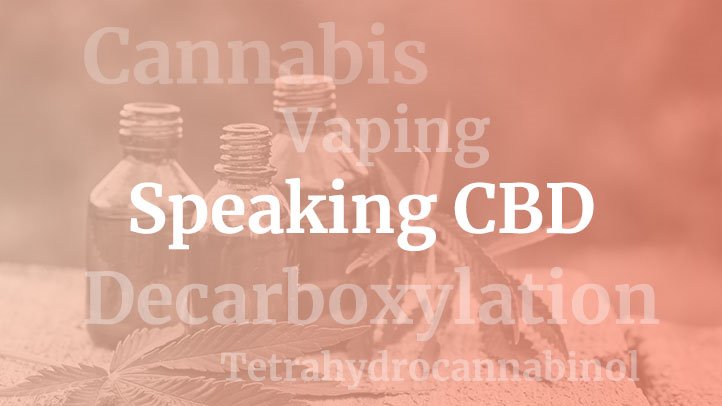Curious about cannabidiol (CBD) and cannabis (aka marijuana)? Here’s the lowdown on the vocabulary you’ll need to ask questions and learn more.
Cannabidiol (CBD), a chemical derived from the cannabis (marijuana) plant, is everywhere these days. It has been touted as a treatment for a range of health issues, including seizures, anxiety, insomnia, chronic pain, and arthritis. If you’re thinking of trying it, it’s important to know the lingo surrounding CBD so that you understand what it is you’re buying or using. The glossary below will make it easier for you to parse the technical terminology as well as the not-so-scientific vernacular — aka, slang — you’ll need to speak CBD.
Aeroponics A cultivation technique in which plants are grown in an environment dependent on air rather than soil. In this system, seeds are embedded in foam stuffed into tiny pots that hold the stem and root mass in place. Plants are nurtured via light and a fine mist enriched with nutrients.
Alcohol Extraction A method commonly used to extract cannabinoids from cannabis plants. In this process, cannabis is first soaked in an alcohol, such as ethanol, to remove the plant material. The alcohol is removed through evaporation.
Cannabichromene (CBC) One of 120 cannabinoids found in the cannabis plant. CBC is a nonpsychoactive cannabinoid, meaning it does not cause feelings of being high.
Cannabidiol (CBD) The second most prevalent cannabinoid in cannabis, after tetrahydrocannabinol (THC). Cannabidiol has been shown to calm the movements in people suffering from dystonia, a condition characterized by muscle spasms. Research also suggests that it may be helpful for the treatment of anxiety, movement disorders, and pain.
Cannabinoid Any of the various naturally occurring, biologically active chemical constituents of hemp or cannabis, including some that possess psychoactive properties, such as tetrahydrocannabinol (THC). The marijuana plant contains more than 100 different cannabinoids.
Cannabinoid 1 (CB1) Receptor CB1 receptors are found on the surface of certain cells, tissues, and organs, and help regulate biological function. CB1 receptors are present in several regions of the brain and spinal cord and, in lesser quantities, in other parts of the body, such as the endocrine glands and the gastrointestinal and urinary tracts. CB1 receptors mediate the effects of cannabinoids on these organs.
Cannabinoid 2 (CB2) Receptor CB2 receptors regulate the biological function of certain cells, tissues, and organs. CB2 receptors are present on white blood cells and in the tonsils, the spleen, immune cells, and neurons. CB2 receptors help mediate the effect of cannabinoids on these organs and cells.
Cannabinoid Profile The concentration of active cannabinoids in a product or medication.
Cannabinol A crystalline, mildly psychoactive cannabinoid found in small quantities in cannabis. Cannabinol is a breakdown product of tetrahydrocannabinol (THC) that may have a sedating effect.
Cannabis Cannabis refers to a group of three varieties of marijuana plants with psychoactive properties: Cannabis sativa, Cannabis indica, and Cannabis ruderalis. Cannabis contains more than 120 chemical and biologically active components, known as cannabinoids.
Cannabis Indica A strain of cannabis known for higher concentrations of tetrahydrocannabinol (THC). Also called indica, it is known for its sedative effects. Because indica contains higher concentrations of THC, it is popular as a recreational and medicinal drug.
Cannabis Sativa A strain of cannabis known for promoting a cerebral high. Also known as sativa, it has hallucinogenic, hypnotic, sedative, analgesic, and anti-inflammatory effects.
Closed-Loop Extraction An extraction method in which solvents aren’t exposed to the open air. Used in the past to produce perfume and beauty products, the process has been used more recently to create cannabis concentrates.
Concentrates (or Extracts) Cannabis concentrates, or extracts, are significantly more potent than a standard cannabis bud or flower. They are processed to keep only the most desirable medicinal compounds while removing excess plant material. Concentrates are often developed for medical applications.
Cultivator An individual who grows marijuana plants, usually with a focus on soil quality and plant health.
Cure A process used to preserve the cannabis plant and retain its flavors and therapeutic properties. Curing involves removing moisture from the flowers under controlled environmental conditions.
Dabs and Dabbing Dabs are concentrated doses of cannabis that are made by extracting tetrahydrocannabinol (THC) or CBD using a solvent like butane; the resulting sticky oils are sometimes referred to as wax. Dabbing is the flash vaporization and inhalation of these concentrates. CBD dabbing is noted for its quick therapeutic effects.
Decarboxylation The process of applying heat to activate and release the CBD and tetrahydrocannabinol (THC) in cannabis.
Dispensary Medical cannabis dispensaries are designed to give people a secure location to gather information and purchase cannabis grown to treat ailments. Laws regarding access vary by state.
Dosing The quantity of medicine prescribed at one time. Dosing CBD depends on therapeutic goals, as well as how it is ingested or applied.
Dronabinol (Marinol and Syndros) Dronabinol is a man-made form of a natural substance in marijuana, and it is often used to treat loss of appetite and weight loss in people with cancer or HIV infection. Marinol and Syndros are common brand names of for dronabinol.
Edible Food or candy products infused with marijuana. There are no noticeable differences in the health benefits of marijuana that is smoked or vaporized versus consumed in an edible form. However, edibles must be digested in order to take effect, and as a result, it may take more time to feel their effects.
Electronic Smoking Device An electronic smoking device generally consists of a mouthpiece, a battery, a cartridge containing an e-liquid (a mixture of water, flavoring, and an active chemical component), and a heating component powered by a battery. These devices are often referred to as vaporizers, vapes, or e-cigarettes.
Endocannabinoid System (ECS) A biological system within the human body that includes cannabinoid receptors capable of interacting with the active chemical compounds of cannabis.
Extraction Extraction techniques are used to separate the chemical components of cannabis from the plant matrix.
Flower The smokable portion of the female cannabis plant.
Hemp An industrial plant cultivated for its fiber and edible seeds. While hemp is in the same family as the cannabis plant, it does not have psychoactive effects. Commercial items made from hemp fiber include paper, textiles, clothing, biodegradable plastic, and food.
Homogeneity This refers to testing to ensure the genetic consistency across strains of cannabis, or to the even distribution of tetrahydrocannabinol (THC) or CBD in a product, such as an edible.
Hybrid A strain that mixes two varieties of cannabis, indica and sativa.
Hydroponics The method of growing a plant without soil. Sand, gravel, water, and other materials may take the place of dirt.
Marijuana The dried leaves and flowers of the cannabis plant. Slang names for marijuana include weed, herb, and pot.
Cesamet (Nabilone) A synthetic cannabinoid prescribed for severe nausea and vomiting caused by cancer treatments like chemotherapy.
Pharmacokinetic and Pharmacodynamics The way drugs are absorbed, distributed, metabolized, and excreted in and from the body.
Retailer A person (or business) who sells goods to the public. Major retailers including CVS Health, Walgreens, and Rite Aid all sell CBD products.
Route of Administration The path by which a drug or substance is taken into the body. An example might be a medication that is taken in pill form (oral administration) or applied to the skin (topical application).
Schedule 1 Drug Schedule I drugs are those that have no accepted medical use and a high potential for abuse.
Strain A strain refers to the different varieties of cannabis. Some examples include indica, sativa, and hybrid.
Synthetic Cannabis Synthetic cannabis, such as Spice and K2, refers to products using man-made chemicals. Some people may use synthetic cannabis as an alternative to marijuana. The Centers for Disease Control and Prevention warns that the effects of synthetic cannabis on the body can be unpredictable, harmful, and very different from those of marijuana.
Terpene The aromatic and flavorful component of the essential oils contained in plants. More than 100 terpenes have been identified in the cannabis plant.
Tetrahydrocannabinol (THC) The main active psychoactive constituent of cannabis. It is responsible for the high sensation.
Tetrahydrocannabinolic Acid (THCA) A cannabinoid that does not have psychoactive effects. It is the precursor to THC. As the plant dries, THCA slowly converts to THC. The potential medicinal properties of THCA are still under study.
Tincture A liquid that contains a concentrated herbal extract.
Topical An oil, salve, lotion, or ointment infused with CBD that can be applied directly to the skin.
Vaporizer A device intended to vaporize substances for inhalation. Vaporizers can be used to heat dried cannabis, cannabis oil, or cannabis wax; they convert the active ingredients into a cannabis-infused aerosol that can be inhaled.
Vaping Inhaling a vaporized substance generated by an electronic vaporizer.









